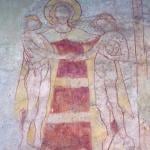Fr. Jim Martin is a brave man. He has made a personal crusade of re-interpreting and revivng devotions and figures commonly dismissed as mawkish. In My Life with the Saints — and ever since — he’s argued heroically and convincingly that Thérèse of Lisieux was more than a sickly gamine with a flair for melodrama; she was a woman of mature faith whose fondest wish was to get greased in ‘Nam. Last week, in America, Fr. Jim makes his pitch for the Sacred Heart of Jesus. He knows what he’s up against. As he points out, whenever a “lazy novelist” wants to alert readers that his Catholic characters are dimwitted or superstitious, he has only to write an olegraph of the Sacred Heart onto their wall.
Boy, is he right. In fact, I can cite a specific instance where an author uses the Sacred Heart as a warning sign. In one sequence in Angela’s Ashes — marketed as a memoir, but heavily fictionalized — Frank McCourt describes how a well-off schoolmate invites him and another poor boy home for lunch. After making a show of blessing himself from the family’s private supply of holy water, the vicious creature treats himself to a ham sandwich, delighting in the longing on the faces of the two urchins. Then, for good measure, Little Lord O’Fauntleroy escorts each of his classmates to the bathroom and watches reverently as they do their business. A house sporting an image of Jesus’ heart, thorn-gouged and aflame, we’re meant to understand, is no better than a well-scrubbed truck stop.
One fact that raises the whole notion of a Christian civilization above the dignity of a pub boast was the co-existence of low and high versions of Christian culture. Granted, some of the more folkloric strains of Christian low culture — cults of saints who never existed, apocrypha about the child Jesus, superstitions and hexes — might have been other than orthodox. The mass-produced strain — precious images of the Sacred Heart and the Immaculate Heart, St. Francis bird baths and cupidlike Infants of Prague — might have been other than classy. But at least they were there, proof that Christianity contained enough material to spark the imagination, and to cater to every taste and temperament.
Architecture people will tell you that tackiness entered the Church in the 1940s, with the emergence of High Modernism, and proliferated with liturgical reform. Where buildings are concerned, that may be true. But I’m afraid, maybe groundlessly, that my fellow simple faithful will start equating modern with low and traditional with high in all cultural spheres. As an analog to the notion that every priest was Bing Crosby (and every nun Ingrid Bergman) until the damn hippies ruined everything, they might convince themselves that every parish church once sported a fresco painted by Da Vinci, or at least Fra Dolcino. Bad art comes from capitulation to the dictatorship of relativism.
I’ve found, on the contrary, that Christianity at its most self-confident is often Christianity at its kitschiest. Across the street from the Moscow hostel where I stayed was a church dedicated to St. Nicholas, a single glance at which could give a visitor diabetes. White with green trim, it had five onion domes, each painted royal blue with big gold stars. If I’d seen a sign reading: “TRANSPORTED PLANK BY PLANK FROM WALT DISNEYWORLD, ORLANDO, FLA, THROUGH THE GENEROUS PATRONAGE OF N.V. ______SKI,” i would not have blinked. Yet it dated back to the 1670s, when Russians were butchering each other over their own liturgical reforms.
Closer to home, I recently saw some photos of a schismatic traditionalist church in the American Midwest that looked like Graceland with incense. If I remember correctly, the tabernacle featured a pair of kneeling angels in apparent tribute to the Ark of the Covenant. But the angels were so…angelic, they could have been stolen from some Milwaukee grandmother’s tchotchke cabinet. From my mole in the sect, I learned that nobody fussed less over Catholic identity than the people who worshiped there. They believed what they believed and voted how they voted. Aside from some bad write-ups courtesy of the Southern Poverty Law Center, the World never demanded that they justify their existence.
A few months ago, I wrote a piece praising Christian cinema precisely because so much of it is sentimental, predictable, preachy and intellectually unchallenging. At the time, I took it for granted that my readers, simply because they were Catholic, would agree that this stuff is good for the soul, at least in moderation. Since then, I’ve come to undertstand that schmaltzy movies and kitschy artwork play a special role in my faith formation: they help me mourn my lost spiritual childhood. Coming into the Church as an adult, I naturally grabbed straight for the hard stuff — The Seven-Storey Mountain, The Dark Night of the Soul. Barely having combed the chrism out of my hair, I found it all very intimidating — Watch that next step; it’s a lulu!
One day, a converted fundie friend showed me the website of a character called Psalty, the Singing Songbook. From what I gathered, Psalty and his friends (also books, plus Charity Churchmouse), provided wholesome, Bible-backed entertainment for her and her brother back before Ma and Pa Grape were even seeds in anyone’s imagination. Barely had Psalty and the gang reached the second verse of “Mustard Seed Faith” when I started bawling. “I NEVER HAD A JESUS-LOVES-ME PHASE,” I explained, through tears. “FOR FUCK’S SAKE, IT’S JUST NOT FAIR.”
Yeah, yeah — Jesus-loves-me is a Protestant phase. Catholic spiritual childhoods are all about nail-biting terror. As luck would have it, I got that part down — thanks, in part, to a piece of Catholic kitsch. In the hallway of her town home, my great-grandmother had hung an Ecce Homo. You can picture it, I’m sure. It was the type of image that inspired the visuals in every boxing movie from Rocky to Raging Bull.
Anyway, getting to her bathroom meant walking alone through that noiseless hallway, past that thing. Having heard somewhere about a Holy Ghost, I expected the ravaged head to spring to life with a cackle and roll out of the frame to bite me. Whether this thought upset my bodily functions as badly as a voyeur would have done I don’t know. If I end up in the same place with the late Frank McCourt, we’ll have to compare notes. What I will say is that the perfect cure for kitsch-angst would have been…more kitsch. A Mary with Deborah Kerr’s high coloring would have worked like Xanax.
Now, I can understand why Catholics more fully formed than I am would get a little impatient with all the sap. I’d just beg them to consider that it plays a vital part in the cultural ecosystem. Like the unlovely cockroach, it’s there for a reason. The next time they click their tongues over the Divine Mercy image, let them remember that a smiling, friendly Jesus remains the bottom line for some of us.
And it’s not like I have no taste at all. To mark my baptism, a group of online friends, who’d appointed themselves my cyber-sponsors, sent me a spiritual bouquet with the works — smiling Marys, smiling Jesuses, even a card, embossed with golden roses, promising that I’ll remain forever in the prayer intentions of the Discalced Carmelites. I wouldn’t be caught dead with any of it on my wall or shelf, but sometimes when I’m feeling especially low, I’ll look through it, after removing it from the brown envelope where it stays hidden, like so many girlie mags.











